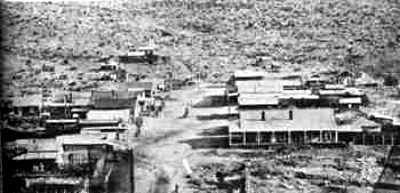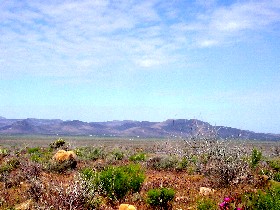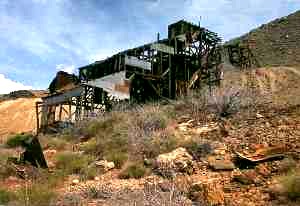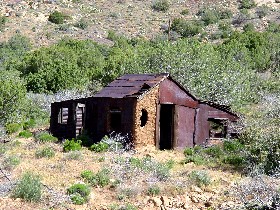|
||||||
|
Mining continued
into the nineteenth century but the town began to die. By 1912, its
post office had closed.
Today, the Golden Gem Mill and head
frame still stand among scattered debris. Nothing else is left of this
once vibrant city.
According to some reports, caution should be utilized in
exploring this area as there is a deep, uncovered shaft not far from the
base of the mill.
Cerbat is nine miles northwest of
Kingman on U.S. 93 at a historical marker
near Milepost 62. Here, you get off the highway on a dirt road,
heading east for 0.7 mile, then left for 0.6 mile, then right again for
another two miles. The last stretch of this road requires a high
clearance vehicle or a willingness to walk.
Named for the
rich minerals in the juniper-filled basin at the foot of Ithaca Peak,
Mineral Park was founded in 1871. Growing quickly the settlement
soon had almost 700 residents, becoming the biggest settlement in the
county. A post office was established on December 31, 1872. Just a year later,
Mineral Park took the title of county seat from nearby
Cerbat.
|
||||||

Mineral Park
Arizona, 1880, courtesy Mohave Historical
Society
|
||||||
|
In
addition to the mines of the area, the town became a supply point for more
distant mines and a growing number of cattle ranches. Ready to last
the duration the town soon had an assay office, five smelters, a hotel, a
restaurant, several stores and a number of saloons. Two stagecoach
stations were present in
Mineral Park and in 1882; a weekly newspaper called the Mohave
County Miner began. In 1883, Mineral Park prospered further when the Atlantic and Pacific Railroad
was completed just 20 miles to the south. This cut the costs of
transporting ore and supplies dramatically.
However, what Mineral Springs didn’t count on was the small
settlement of
Kingman, built to service the railroad,
would begin to grow so fast. In spite of the
Mohave County Miner's best efforts
to downplay the possibility of
Kingman ever amounting to much, over the
next five years,
Kingman continued to prosper as a supply
center for the area mines, as well as a commercial center for travelers
through the area.
|
||||||
|
Mineral Park today has very little left,
April, 2005.
|
Soon, Mineral Park was to experience more civic embarrassment when a
county-wide vote made
Kingman the
new county seat in 1887.
Kingman got
271 votes to Mineral Park's 93. Even Hackberry, located some 30 miles
northeast of
Kingman got more votes than Mineral Park at 132. Many speculated that
Mineral Park merchants, who already had some economic connections with
Kingman,
were interested in reducing their costs by being closer to the railroad.
Despite the conclusiveness of the polls,
Mineral Park officials refused to give up the county records. Outraged,
Kingman citizens subsequently raided the town hall and made off with
the county documents, literally "taking” the county seat.
The Mohave County Miner, once the
biggest critic of moving the county seat to
Kingman,
gave in to economic reality and made the move from Mineral Park to the new county seat of
Kingman.
|
|||||
|
Losing the
county seat was just the beginning of the end for Mineral Park. After 1887, some of the mines began to close.
Though some were reopened briefly in the early 1900s, the town never
recovered and its post office closed for good on June 15, 1912. Today Mineral Park has all but vanished and sits upon private mining property where turquoise and copper are still being mined from the area. An open-pit mine, formerly operated by the Cypress-Bagdad, has caused once-prominent Ithaca Peak to disappear completely. The area is scattered with the debris of earlier days, where head frames, mill foundations and tattered cabins can still be seen amongst the mine tailings. Mineral Park's small cemetery is one of the best-preserved in Arizona. Although it is within mine property, it can still be viewed by contacting the current mining operation.
To get to Mineral Park, you will travel some 14 miles northwest of
Kingman on
US 93 to a turn-off between Mileposts 58 and 59. Here, there is a
historical marker where you will turn east for 4.3 miles on paved road,
then left 0.3 mile on a well-used gravel road (the turn is just before the
fenced-in modern mine.)
| ||||||
Monday, March 16, 2015
The Cerbat Mountain Range, Kingman Arizona
Monday, March 9, 2015
Why Hire a Real Estate Agent
Why Hire an Agent
It’s no secret that the real estate industry has evolved in
numerous ways over the last decade. With the internet and mobile devices taking the market by storm, buyers
have unprecedented access to property information at their fingertips, without
depending on a real estate agent.
In some instances, property searches have been abandoned altogether by real estate professionals in an attempt to make themselves more efficient with their time. Some agents assume that since the majority of consumers search for homes online, it has somehow become the consumer’s responsibility rather than their agent. So that begs the question, are buyer’s agents still necessary? In short, yes and here’s why.
In some instances, property searches have been abandoned altogether by real estate professionals in an attempt to make themselves more efficient with their time. Some agents assume that since the majority of consumers search for homes online, it has somehow become the consumer’s responsibility rather than their agent. So that begs the question, are buyer’s agents still necessary? In short, yes and here’s why.
For starters, home buyers should not always rely on the
sometimes partial or outdated information that many online sources
provide. But more importantly, a good
buyer’s agent will still carry out many tasks in the buyer’s best interest —
tasks that reach far beyond the property search function. Here is a condensed list of the essential
tasks that should be handled by a qualified buyer’s agent:
- Be an adviser and be available during the entire home buying process. When an agent sells homes every month and every week day in and day out they become very familiar and aware of what is needed to get the deal worked out.
- Take time to uncover the buyer’s needs and wants as well as what’s motivating their purchase.
- Educate buyers on current local market conditions. Nationwide or statewide conditions don’t always reflect what is going on in the immediate area.
- Find a way for buyers to attain as many of their needs possible when dealing with the realities of the marketplace or financial constraints that they may have. A lot of times buyers agents are very familiar with the best lenders or will be able to work out deals with banks when their credit is not perfect. Contingencies with buying or selling a home can also be taken care of by an experienced buyers representative at Chambers Realty Group.
- Research homes in the area and sort through active listings to make suggestions after cross-referencing buyer’s needs (i.e. Which homes are located in areas that have retained home values? Which homes are located inside good school districts? Lower taxed areas? Easy work commutes? Areas of low crime? etc.)
- Help buyers achieve their lifestyle needs with a different set of features than originally anticipated (this is particularly useful when dealing with financial constraints)
- Aid buyers in narrowing their search until they have identified their top choices
- Handle the ins and outs of the negotiation process including the preparation of all necessary forms when making an offer and/or counteroffer.
- Provide oversight and follow up for any inspections deemed necessary.
- Counsel buyers on how to handle any repairs needed on the property. At our office we keep an updated list and record on reputable builders and repair persons. People that we trust to work on our own homes.
Buyer’s agents are no longer the gatekeepers of property
information, but understanding, evaluating, and presenting that property
information to home buyers remains an integral part of an agent’s job. If done properly, everyone benefits.
Justin Chambers with Chambers Realty has sold over 1000 homes and land sales, making him one of Mohave
County’s top agents for the last 11
years. This experience has given him a
unique perspective on the Kingman Arizona Real Estate found at chambersrealtygroup.com
worth paying attention to.
Thursday, March 5, 2015
Nice Article about water usage from the Kingman Daily Miner this Morning
Nice Article from the Kingman Daily Miner this Morning
KINGMAN - Mohave County needs to do everything it can to conserve water and gain political control of groundwater rights, the Planning and Zoning Commission was told Tuesday during a public workshop on the general plan.
Kingman is losing about 7,000 acre-feet a year of groundwater supply from the Hualapai Basin, and the city's aquifers could run dry after about 100 years, geologist Luis Vega said during his presentation at the two-hour workshop.
Approximation on the amount of water available in the basin seems to be a "whipping point" for a lot of people, Vega said.
"They say we can't tell how much water is in the basin. That's not true," Vega said.
He referred to a 2013 study by the U.S. Geological Survey that establishes a model for the impact of water discharge and recharge. It showed 10,000 acre-feet of recharge a year and 17,000 acre-feet going out, including 8,900 acre-feet to the city of Kingman.
"The real question is not how much water down to the gallon is in Hualapai Basin," Vega noted. "That's like counting deer on Hualapai Mountain. You might count the same deer three or four times. The real question is whether it's going down or up, and what is the impact going to be."
That was the concern of about 25 people who attended the workshop at Mohave County Public Works' Turquoise Room.
One man said he understands the furor over Jim Rhodes and Kingman Farms drawing an estimated 25,000 acre-feet to grow alfalfa in the Red Lake area, but conservation is the bigger picture.
A member of the Hualapai tribe encouraged county officials to "aggressively" pursue a management plan that would include a full assessment of water resources and promote water conservation, like collecting rainfall.
Another citizen wanted to know if anyone at the county level is keeping tabs on the total amount of water being used. Is there a "dynamic process" in place that says we're at our limit for drawdown, or is it reviewed every five years?
"For far too long, this state has given water to other states," another man said. "When you need a drink and it's not there, you're going to do whatever you need to get it."
Mohave County deputy attorney Robert Taylor said the county doesn't have much control over groundwater resources. Groundwater, or water under the surface of the Earth, is not subject to appropriation or ownership, he said.
"There's not much regulation outside of an AMA (Active Management Area)," Taylor said. "It's reasonable use, which means the property owner has the right to capture water for beneficial use, but can't take water away from the property."
The focus for counties outside of an AMA has been how to obtain water, rather than monitoring use, he said.
The Planning and Zoning Commission and Board of Supervisors are authorized to consider the impact of water supply when considering land use zoning, and those concerns can be addressed in developing the general plan, Taylor added.
Vega said the Arizona Department of Water Resources controls water use inside an Active Management Area, but there are no measuring devices required on wells outside an AMA and no reporting required.
County residents should "beware of unintended consequences" when making water management decisions, Vega said. ADWR's safe-yield, in which usage is balanced by recharge, cannot be attained in Mohave County, even with no growth, he said.
"Eventually, the Hualapai aquifer will run dry," Vega said. "It might not be in our lifetime. One of the things we need to do is stop low-priority, high-volume use such as agriculture."
Arizona law exempts agriculture and mining from the well permit process, said Nick Hont, director of development services.
"They just do it. People don't come to the county, they just drill a well and pump," Hont said. "They just have to put it to beneficial use."
"Right now, local government is severely limited in what we can do to protect water supply," added Steve Moss, chairman of the county Board of Supervisors.
It's a political battle, and Mohave County doesn't have "big guns in that fight," Moss said.
Voters in Phoenix and Tucson have more power, and when water allocation from the Colorado River is cut and the pressure is on for water supply, they're going to say their demands are greater than Mohave County's, Moss said.
"Engage with state legislators," he told the audience. "If we throw ourselves into the hands of ADWR, we throw ourselves into the fire. I don't think an AMA or INA is the way to go. I believe there are local measures to take, but asking Phoenix or Maricopa (County) to save us - bad idea."
KINGMAN - Mohave County needs to do everything it can to conserve water and gain political control of groundwater rights, the Planning and Zoning Commission was told Tuesday during a public workshop on the general plan.
Kingman is losing about 7,000 acre-feet a year of groundwater supply from the Hualapai Basin, and the city's aquifers could run dry after about 100 years, geologist Luis Vega said during his presentation at the two-hour workshop.
Approximation on the amount of water available in the basin seems to be a "whipping point" for a lot of people, Vega said.
"They say we can't tell how much water is in the basin. That's not true," Vega said.
He referred to a 2013 study by the U.S. Geological Survey that establishes a model for the impact of water discharge and recharge. It showed 10,000 acre-feet of recharge a year and 17,000 acre-feet going out, including 8,900 acre-feet to the city of Kingman.
"The real question is not how much water down to the gallon is in Hualapai Basin," Vega noted. "That's like counting deer on Hualapai Mountain. You might count the same deer three or four times. The real question is whether it's going down or up, and what is the impact going to be."
That was the concern of about 25 people who attended the workshop at Mohave County Public Works' Turquoise Room.
One man said he understands the furor over Jim Rhodes and Kingman Farms drawing an estimated 25,000 acre-feet to grow alfalfa in the Red Lake area, but conservation is the bigger picture.
A member of the Hualapai tribe encouraged county officials to "aggressively" pursue a management plan that would include a full assessment of water resources and promote water conservation, like collecting rainfall.
Another citizen wanted to know if anyone at the county level is keeping tabs on the total amount of water being used. Is there a "dynamic process" in place that says we're at our limit for drawdown, or is it reviewed every five years?
"For far too long, this state has given water to other states," another man said. "When you need a drink and it's not there, you're going to do whatever you need to get it."
Mohave County deputy attorney Robert Taylor said the county doesn't have much control over groundwater resources. Groundwater, or water under the surface of the Earth, is not subject to appropriation or ownership, he said.
"There's not much regulation outside of an AMA (Active Management Area)," Taylor said. "It's reasonable use, which means the property owner has the right to capture water for beneficial use, but can't take water away from the property."
The focus for counties outside of an AMA has been how to obtain water, rather than monitoring use, he said.
The Planning and Zoning Commission and Board of Supervisors are authorized to consider the impact of water supply when considering land use zoning, and those concerns can be addressed in developing the general plan, Taylor added.
Vega said the Arizona Department of Water Resources controls water use inside an Active Management Area, but there are no measuring devices required on wells outside an AMA and no reporting required.
County residents should "beware of unintended consequences" when making water management decisions, Vega said. ADWR's safe-yield, in which usage is balanced by recharge, cannot be attained in Mohave County, even with no growth, he said.
"Eventually, the Hualapai aquifer will run dry," Vega said. "It might not be in our lifetime. One of the things we need to do is stop low-priority, high-volume use such as agriculture."
Arizona law exempts agriculture and mining from the well permit process, said Nick Hont, director of development services.
"They just do it. People don't come to the county, they just drill a well and pump," Hont said. "They just have to put it to beneficial use."
"Right now, local government is severely limited in what we can do to protect water supply," added Steve Moss, chairman of the county Board of Supervisors.
It's a political battle, and Mohave County doesn't have "big guns in that fight," Moss said.
Voters in Phoenix and Tucson have more power, and when water allocation from the Colorado River is cut and the pressure is on for water supply, they're going to say their demands are greater than Mohave County's, Moss said.
"Engage with state legislators," he told the audience. "If we throw ourselves into the hands of ADWR, we throw ourselves into the fire. I don't think an AMA or INA is the way to go. I believe there are local measures to take, but asking Phoenix or Maricopa (County) to save us - bad idea."
Subscribe to:
Comments (Atom)


